 Auguste Renoir, Bal du Moulin de la Galette, 1876. Musée d'Orsay, Paris.
Auguste Renoir, Bal du Moulin de la Galette, 1876. Musée d'Orsay, Paris.
After having discovered the inspirations of the Impressionist movement (Impressionist Saga: Episode 1), today we focus on the birth of this avant-garde and deeply subversive movement. Throughout our analysis, you will finally find the answers to your most recurrent questions:
Why and how was Impressionism born?
Where does the term "impressionism" come from?
1. How was the Art world before?
It was the early 1860s when the first painters, later called Impressionists, began their experiments. At that time, the French art world was in a very different situation than the one we know today. The vast majority of artists owed their careers to the Royal Academy of Painting and Sculpture, created in 1648.
 Thomas Couture, The Romans in their Decadence, 1847. Musée d'Orsay. Couture was a mega-star of academic art.
Thomas Couture, The Romans in their Decadence, 1847. Musée d'Orsay. Couture was a mega-star of academic art.
This Academy functioned like an administration: it directed artistic teaching, organized competitions for access to studios and exhibitions, had a monopoly on royal commissions, and dictated a strict theoretical program for anyone who wished to make painting their sole means of subsistence.
Of course, it was first founded with a virtuous purpose: to put an end to guilds and to hereditary transmission of the artist's profession in order to allow access to the most passionate (well, one still had to have solid financial means to survive and to pay the studio masters, but it was no longer necessary to be a painter's son to become one, and that's something!)
Unfortunately, with time, the honest intentions of this institution faded away, leaving a deeply ruthless system. Too rigorous, the academy is stuck in a bygone era: since its creation, it has taken Greco-Roman art and the masterpieces of antiquity as its model. It therefore quickly became a brake for new artists in search of new subjects and new techniques.
 Jacques-Louis David, Patroclus, 1780. Thomas-Henry Museum, Cherbourg, France.
Jacques-Louis David, Patroclus, 1780. Thomas-Henry Museum, Cherbourg, France.
Among the immutable principles imposed by the academy on future painters, we find these kinds of rules:
- Not all subjects are equal in terms of good taste: the most noble subjects are obviously genre scenes (mythology, religion, history) because they convey a moral message. On the other hand, scenes of daily life, still life and landscapes are shunned because they're considered futile and of no great interest (you can already see the problem of the impressionists).
- Knowing how to draw nudes, everywhere, all the time: because, as during the Renaissance, one considers that man is at the center of everything, one must train oneself to permanently glorify the beauty of his body. Why not.
- Drawing yes, but for the color we will see: for the academicians, if there's no drawing, then painting cannot exist. The lines and curves must be perfect, and the color must correspond to reality (poor impressionists!).
- To paint in the studio or not to paint: for the academy, paint outdoors is OK, but only for preparatory drawings and sketches. Real artists must paint by candlelight in their studios.
- Imitate rather than innovate: because the Ancients had understood everything, it's enough to imitate ancient art to be considered a good artist.
 Hippolyte Flandrin, Study (Young Male Nude Seated beside the Sea), 1836. Musée du Louvre. A luscious artwork.
Hippolyte Flandrin, Study (Young Male Nude Seated beside the Sea), 1836. Musée du Louvre. A luscious artwork.
To finish convincing you how difficult it can be to bypass the Academy: at that time, art galleries as we think of them today didn't exist. There was only one way to exhibit one's work: Le Salon Officiel. To enter this annual exhibition, you had to submit your artwork to a jury... composed of members of the Academy. This meant that emancipated souls were rejected without mercy and could say goodbye to their artistic ambitions.
For many years, this system worked wonderfully, building legends such as Jacques-Louis David, Jean-Auguste-Dominique Ingres or Nicolas Poussin. Other celebrities followed, including Eugène Delacroix and Théodore Géricault. More modern, they regularly broke the rules imposed by the Academy.
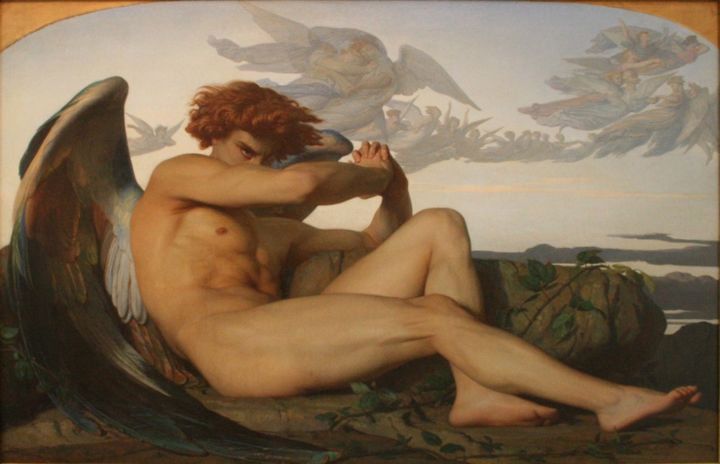 Alexandre Cabanel, Fallen Angel, 1847. Fabre Museum, Montpellier.
Alexandre Cabanel, Fallen Angel, 1847. Fabre Museum, Montpellier.
In 1860, when the premises of the future impressionism appeared, the academic stars of the time were called Bouguereau, Flandrin or Cabanel. These names will quickly sink into oblivion despite a handful of masterpieces, because of (or thanks to) the rise of a lighter and more innovative painting proposed by Renoir, Monet, Manet and their friends.
2. Academicians, go to hell!
The history of Impressionism is first and foremost the history of dissidence: the epic of a group of revolutionary artists, annoyed by the omnipotence of academic art: an omnipresent, wise, and codified art, approved by the administration, and outside of which it was impossible to perform.
From the 1860s onwards, we witnessed the quiet emergence of a new kind of artist: they were tired of academicism, puritanism, and romanticism, which had constipated their creative ardor for far too long. They wish to add more subjectivity to their artworks, to express their sensitivity through the prism of their brushes.
 Claude Monet, A Seascape, Shipping by Moonlight, 1864. National Gallery of Scotland.
Claude Monet, A Seascape, Shipping by Moonlight, 1864. National Gallery of Scotland.
These artists still share some common notions with the academic painters: they use models to make their paintings: landscapes, muses, models, fruit corbels and flower vases remain essential to their creative process.
However, the artistic conceptions diverge as to the desired result: where the academicians wish to represent reality in the best way, without alterations and to perfection, the aspiring impressionists wish to model reality in their own way, according to their feelings, their emotions, the weather and the luminosity: according to their impression of the landscape or the model they're looking at.
 William Bouguereau, Peace, 1860. Saint Louis Art Museum. A very academic artwork.
William Bouguereau, Peace, 1860. Saint Louis Art Museum. A very academic artwork.
Academism and Impressionism, too many things separate them:
- Academicians favored studio work, Impressionists preferred working outdoors.
- Academicians respect many moral and pictorial conventions; Impressionists have no guidelines. They detach themselves from the rules inherited from religion and enjoy a particular freedom in the treatment of their subjects.
- Academicians tried to capture the static beauty of a bygone era; Impressionists tried to capture the evolution of life.
- Academicians were overwhelmed by royal and bourgeois commissions, Impressionists survived penniless or took advantage of their family fortune to evolve in the face of general incomprehension.
As you can see, the Academicians were noblemen, merchants, and peacekeepers, while the Impressionists were revolutionaries, pirates, and rioters. The Academy was a dictatorship that they had to overthrow. Their weapons: brushes, oil and... a lot of ambition. We're gradually witnessing what we could call... a gentle revolution.
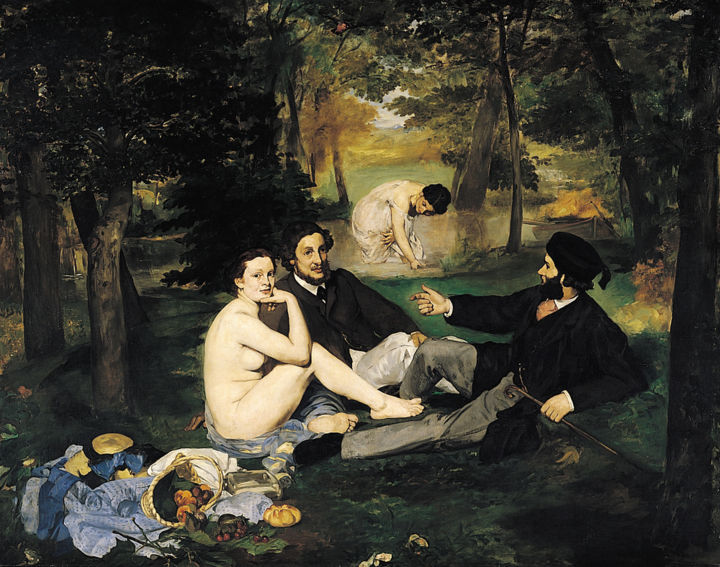 Édouard Manet, Luncheon on the Grass, 1863. Musée d'Orsay, Paris.
Édouard Manet, Luncheon on the Grass, 1863. Musée d'Orsay, Paris.
3. Formation of a group
During the 1860s, the various painters aspiring to Impressionism gradually came together and found a common desire to bypass the rules imposed by the Academy.
Claude Monet met Camille Pissarro in 1860, during drawing lessons in the studio of Charles Suisse. Two years later, in the studio of Charles Gleyre, Auguste Renoir, Frédéric Bazille, Alfred Sisley and Monet met and decided together to separate from this teacher who was too fascinated by the masterpieces of antiquity. In 1866, Edouard Manet met Renoir, Bazille, Monet and Paul Cézanne at the Café Guerbois in Paris, a drinking establishment that would become their headquarters. Manet added to the group Berthe Morisot (who would become his sister-in-law) and Edgar Degas, who had already known each other for several years.
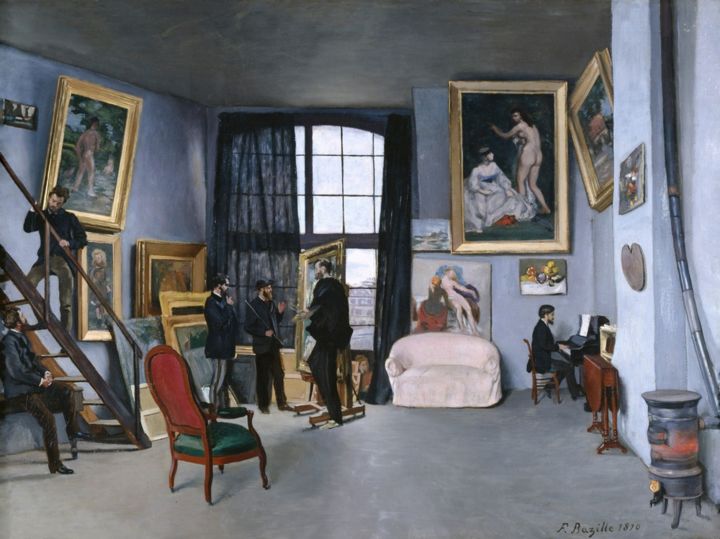 Frédéric Bazille, Bazille's Studio, 1870. Musée d'Orsay, Paris.
Frédéric Bazille, Bazille's Studio, 1870. Musée d'Orsay, Paris.
This artwork is representative of this period of intellectual agitation. It shows Bazille presenting his new artwork to Manet and Monet, while Emile Zola and Renoir discuss together on the left side, across the stairs. Manet also participated in the realization of this painting, painted with four hands.
The little group is talking a lot. And even if they don't all agree, a majority knows that without a common effort they will never succeed in establishing themselves as free artists alongside the impenetrable and already (too) well-established academicians. For several years, they refined their respective styles, and the collective ebullition allowed a creative explosion. Monet and Renoir painted long works side by side on the banks of the Seine and shared a studio with Bazille. Sisley, Cézanne and Pissarro, also friends, joined them regularly. At the Guerbois café, Manet and Degas remade the world (of art). They were all very close to the famous writer Emile Zola, an art critic in his spare time, who also participated in the emergence of this movement through his choice of words.
Among them, most were accepted at the Salon, like Manet, Morisot, Degas, Monet, Renoir or Bazille. However, there were many refusals. Some, like Pissarro and Cézanne, were systematically refused, while others constantly caused a scandal and saw their chances of selection for the next few years diminish over time.
 Paul Cézanne, The Hanged Man's House, 1873. Musée d'Orsay.
Paul Cézanne, The Hanged Man's House, 1873. Musée d'Orsay.
4. Alone against all: Time for confrontation
These fiery artists felt invested with a sacred fire: it was them against the rest of the world, and if the jury didn't accept their artworks, they would find a way to get around this obstacle. They would find this solution in the early 1870s: what if we created our own exhibition on the fringe of the Salon Officiel?
The idea germinated quietly in the minds of these artists. In 1873, they decided to found an association: the society of artists, painters, sculptors and engravers. Behind this not very exotic denomination is hidden the possibility for them to organize events without having to obtain the preliminary authorization of the artistic authorities of the time, dominated by the academicians, who would have necessarily refused such an affront. This society also allowed them to associate together in a purely friendly and professional logic, without having to theorize their respective practices: these artists didn't want to create a school, a manifesto or a common movement, so it was the perfect alternative. Administratively, they formed a group, but individually, they could all evolve without having to respect a strict protocol. The future Impressionists had no desire to return to the draconian rules and regulations that the Academy took such pleasure in imposing.
 Berthe Morisot, The Harbor at Lorient, 1869. National Gallery of Art, Washington.
Berthe Morisot, The Harbor at Lorient, 1869. National Gallery of Art, Washington.
Now they need a place, and funding to set up this whole enterprise. The photographer Nadar, a friend of the Impressionists and the first photographer of such legends as Clémenceau, Baudelaire, Zola, Delacroix, George Sand, Rodin and Jules Verne, had a very well-located studio near the site of the Salon Officiel. He needed money, so he offered to rent his studio to intrepid artists. Paul Durand-Ruel, an art dealer closes to some of the artists, offered to finance part of the costs of organizing the event.
In 1874, everything was ready. 3500 visitors crowded the entrance of the Nadar studios to discover what these painters of a new genre had in store. Obviously, the reactions were ambivalent. Apart from a few open and benevolent minds, the mentalities of the time weren't quite prepared for such a revolution. As we now know, every artistic movement emerges from a break with existing trends. At each new stage of art there's a potential scandal since public opinion always expresses a certain gap with contemporary creation. It was true in 1874, but it' s always the same thing today, as testify some corrosive criticisms towards Conceptual Art, and more recently towards Digital Art or NFT.
 Camille Pissarro, Orchard in Bloom, Louveciennes, 1872. National Gallery of Art, Washington.
Camille Pissarro, Orchard in Bloom, Louveciennes, 1872. National Gallery of Art, Washington.
5. Scandal, criticism: Recipe for popular success
The most famous art critics weren't kind to this young group of ambitious artists. Except for their friend Emile Zola and a few visionaries, they all attacked them with fervor. For Albert Wolff, it's an "appalling spectacle of human vanity going astray to the point of insanity. Make Mr. Pissarro understand that the trees are not purple, that the sky is not of a fresh butter tone, that in no country one can see the things he paints, and that no intelligence can adopt such misguidance.”. Rude.
 Edgar Degas, Washerwomen, 1870-72. Musée Malraux (MuMa), Le Havre. This painting was displayed at the first exhibition.
Edgar Degas, Washerwomen, 1870-72. Musée Malraux (MuMa), Le Havre. This painting was displayed at the first exhibition.
In the columns of Le Figaro, one can read: "The impression given by the Impressionists is that of a cat walking on the keyboard of a piano, or of a monkey that has taken hold of a color box". Another critic with little foresight wrote in the Chronique de l'hôtel Drouot: "As for their current artwork, one day we will see them selling for 50 Francs a pile". In the light of today's and yesterday's auction results, he would certainly have done better to keep his mouth shut.
In 1874, Monet, Renoir and their friends didn't consider themselves as representatives of a new movement. However, they felt that they shared a common vision of what art should become. From their personal opinions and the opinion of the critics, many names are given to them: the New Painting, the New School of Realists, the Independents, the Intransigents, the Impressionalists... However, none of them was really unanimous.
 Paul Cézanne, A Modern Olympia, 1873. Musée d'Orsay. This painting was displayed at the first exhibition.
Paul Cézanne, A Modern Olympia, 1873. Musée d'Orsay. This painting was displayed at the first exhibition.
Thanks to this first exhibition and the sarcasm of the critic Louis Leroy, the term "impressionist" emerged, thus putting a clear and unequivocal word on the practice of artists with common ambitions. In April 1874, Louis Leroy wrote a satirical article commenting on this new kind of exhibition, a cocktail of avant-garde and polemic. In this mocking article, the critic recounts his visit to the exhibition under the cover of a pseudonym, thus allowing him to blast, without any form of trial, this innovative art "attacking artistic morality, cult of form and respect for the masters" (from the article).
With each of his discoveries, he describes his reactions and blasts the paintings one by one. After having spread his devastating sarcasm on the works of Guillaumin, Pissarro, Rouart, Boudin, Morisot and Renoir, he finally stops on Claude Monet's (future) emblematic masterpiece, Impression, Sunrise. His slight sarcasm turned into bitter contempt, and he fulminated: "What does this painting represent? Impression! Impression, I was sure. I also said to myself, since I am impressed, there must be some impression in there". That was all it took to set in stone a qualification with so much meaning. Impressionism was named, and thus born.
 Claude Monet, Impression, Sunrise, 1872. Musée Marmottan, Paris.
Claude Monet, Impression, Sunrise, 1872. Musée Marmottan, Paris.
Is there anything more poetic than an artistic movement born of a sunrise?
Other critics will drive the point home, like Jules Castagnary in the newspaper Le Siècle: "If we want to characterize them with a word that explains them, we will have to forge the new term of impressionists. They're impressionists in the sense that they don't render the landscape, but the impression rendered by the landscape". Clever.
Gradually, Claude Monet and his friends took on this name, making him lose his critical and reproving sense. Their next collective event, in 1876, was therefore entitled "the second Impressionist exhibition". For the public and the critics, the academic painters were gradually going out of fashion. Monet and his friends captured the popular interest, to the detriment of the last representatives of academism (Bouguereau, Cabanel, Flandrin) who mechanically fell into oblivion despite some notable masterpieces.
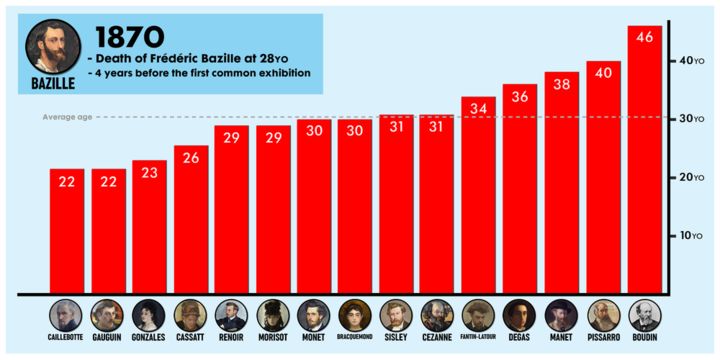 Graphics: Average age of Impressionist artists in 1870 - © Artmajeur
Graphics: Average age of Impressionist artists in 1870 - © Artmajeur
History is in the making, and it's just beginning...
See you next week for our third episode dedicated to the Impressionists. This time we will study in more detail each of the actors of this movement: artists, dealers and critics, friendships, tensions, and betrayals...
You will discover who the Impressionists are, and why there are such differences between the artwork of Edouard Manet and Claude Monet. See you soon!

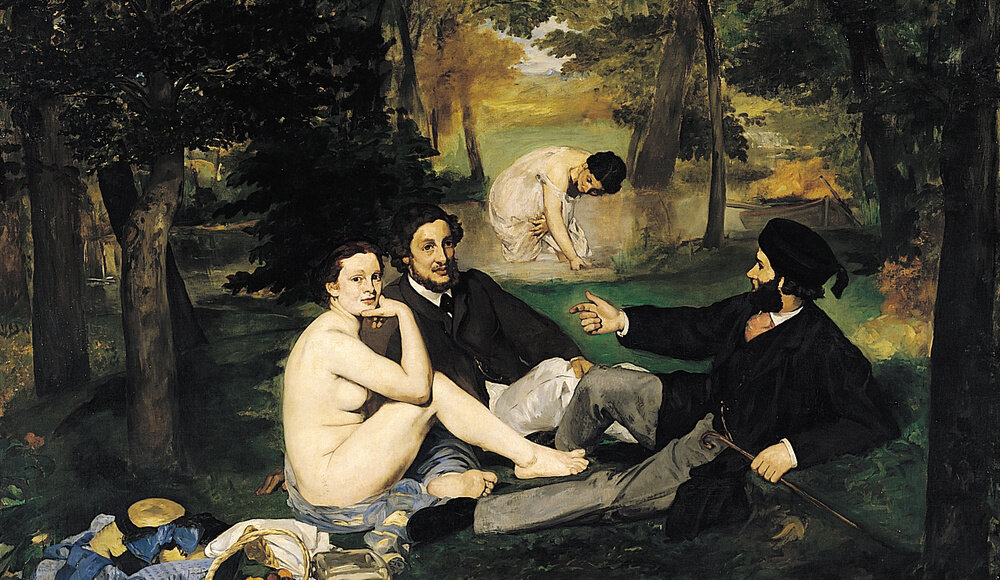
 Bastien Alleaume
Bastien Alleaume